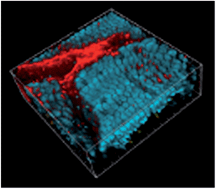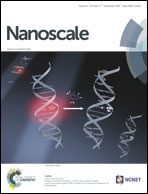CdSe/CdS-quantum rods: fluorescent probes for in vivo two-photon laser scanning microscopy†
Abstract
CdSe/CdS-Quantum-dots-quantum-rods (QDQRs) with an aspect ratio of ∼6 are prepared via the seeded growth method, encapsulated within a shell of crosslinked poly(isoprene)-block-poly(ethylene glycol) (PI-b-PEG) diblock copolymer, and transferred from the organic phase into aqueous media. Their photoluminescence quantum yield (PLQY) of 78% is not compromised by the phase transfer. Within a period of two months the PLQY of QDQRs in aqueous solution at neutral pH decreases only slightly (to ∼65%). The two-photon (TP) action cross sections of QDQRs (∼105 GM) are two orders of magnitude higher than those of CdSe/CdS/ZnS-core/shell/shell quantum dots (QDs, ∼103 GM) with comparable diameter (∼5 nm). After applying PI-b-PEG encapsulated QDQRs onto the small intestinal mucosa of mice in vivo, their strong red fluorescence can easily be observed by two-photon laser scanning microscopy (TPLSM) and clearly distinguished from autofluorescent background. Our results demonstrate that PI-b-PEG encapsulated CdSe/CdS-QDQRs are excellent probes for studying the uptake and fate of nanoparticles by two-photon imaging techniques in vivo.


 Please wait while we load your content...
Please wait while we load your content...